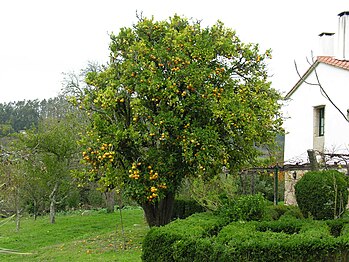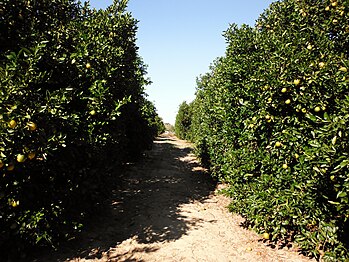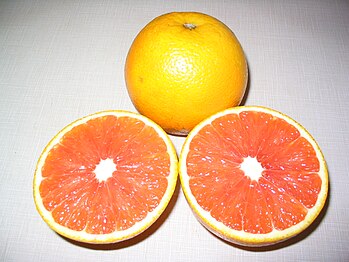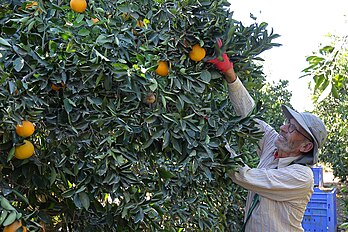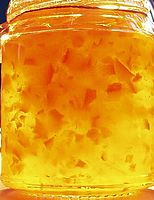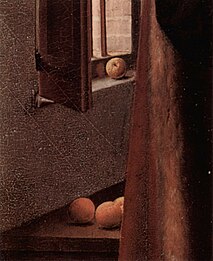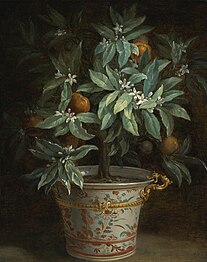Orange (fruit)

An orange, also called sweet orange to distinguish it from the bitter orange (Citrus × aurantium), is the fruit of a tree in the family Rutaceae. Botanically, this is the hybrid Citrus × sinensis, between the pomelo (Citrus maxima) and the mandarin orange (Citrus reticulata). The chloroplast genome, and therefore the maternal line, is that of pomelo. The sweet orange has had its full genome sequenced.
The orange originated in a region encompassing Southern China, Northeast India, and Myanmar; the earliest mention of the sweet orange was in Chinese literature in 314 BC. Orange trees are widely grown for their sweet fruit. The fruit of the orange tree can be eaten fresh, or processed for its juice or fragrant peel. In 2022, 76 million tonnes of oranges were grown worldwide, with Brazil producing 22% of the total, followed by India and China.
Oranges have featured in human culture since ancient times. They first appear in Western art in the Arnolfini Portrait by Jan van Eyck, but they had been depicted in Chinese art centuries earlier, as in Zhao Lingrang's Song dynasty fan painting Yellow Oranges and Green Tangerines. By the 17th century, an orangery had become an item of prestige in Europe, as seen at the Versailles Orangerie. More recently, artists such as Vincent van Gogh, John Sloan, and Henri Matisse included oranges in their paintings.
Description
The orange tree is a relatively small evergreen, flowering tree, with an average height of 9 to 10 m (30 to 33 ft), although some very old specimens can reach 15 m (49 ft).[1] Its oval leaves, which are alternately arranged, are 4 to 10 cm (1.6 to 3.9 in) long and have crenulate margins.[2] Sweet oranges grow in a range of different sizes, and shapes varying from spherical to oblong. Inside and attached to the rind is a porous white tissue, the white, bitter mesocarp or albedo (pith).[3] The orange contains a number of distinct carpels (segments or pigs, botanically the fruits) inside, typically about ten, each delimited by a membrane and containing many juice-filled vesicles and usually a few pips. When unripe, the fruit is green. The grainy irregular rind of the ripe fruit can range from bright orange to yellow-orange, but frequently retains green patches or, under warm climate conditions, remains entirely green. Like all other citrus fruits, the sweet orange is non-climacteric, not ripening off the tree. The Citrus sinensis group is subdivided into four classes with distinct characteristics: common oranges, blood or pigmented oranges, navel oranges, and acidless oranges.[4][5][6] The fruit is a hesperidium, a modified berry; it is covered by a rind formed by a rugged thickening of the ovary wall.[7][8]
-
Flowers
-
Fruit starting to develop
-
Flowers and fruit simultaneously
-
Mature tree in Galicia, Spain, fruiting in November
-
Structure of the botanical hesperidium
History
Hybrid origins
Citrus trees are angiosperms, and most species are almost entirely interfertile. This includes grapefruits, lemons, limes, oranges, and many citrus hybrids. As the interfertility of oranges and other citrus has produced numerous hybrids and cultivars, and bud mutations have also been selected, citrus taxonomy has proven difficult.[9]
The sweet orange, Citrus x sinensis,[10] is not a wild fruit, but arose in domestication in East Asia. It originated in a region encompassing Southern China, Northeast India,[11] and Myanmar.[12] The fruit was created as a cross between a non-pure mandarin orange and a hybrid pomelo that had a substantial mandarin component.[13][14] Since its chloroplast DNA is that of pomelo, it was likely the hybrid pomelo, perhaps a pomelo BC1 backcross, that was the maternal parent of the first orange.[15][16] Based on genomic analysis, the relative proportions of the ancestral species in the sweet orange are approximately 42% pomelo and 58% mandarin.[17] All varieties of the sweet orange descend from this prototype cross, differing only by mutations selected for during agricultural propagation.[16] Sweet oranges have a distinct origin from the bitter orange, which arose independently, perhaps in the wild, from a cross between pure mandarin and pomelo parents.[16]
Sweet oranges have in turn given rise to many further hybrids including the grapefruit, which arose from a sweet orange x pomelo backcross. Spontaneous and engineered backcrosses between the sweet orange and mandarin oranges or tangerines have produced the clementine and murcott. The ambersweet is a complex sweet orange x (Orlando tangelo x clementine) hybrid.[17][18] The citranges are a group of sweet orange x trifoliate orange (Citrus trifoliata) hybrids.[19]

Arab Agricultural Revolution
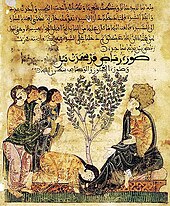
In Europe, the Moors introduced citrus fruits including the bitter orange, lemon, and lime to Al-Andalus in the Iberian Peninsula during the Arab Agricultural Revolution.[20] Large-scale cultivation started in the 10th century, as evidenced by complex irrigation techniques specifically adapted to support orange orchards.[21][20] Citrus fruits—among them the bitter orange—were introduced to Sicily in the 9th century during the period of the Emirate of Sicily, but the sweet orange was unknown there until the late 15th century or the beginnings of the 16th century, when Italian and Portuguese merchants brought orange trees into the Mediterranean area.[11]
Spread across Europe
Shortly afterward, the sweet orange quickly was adopted as an edible fruit. It was considered a luxury food grown by wealthy people in private conservatories, called orangeries. By 1646, the sweet orange was well known throughout Europe; it went on to become the most often cultivated of all fruit trees.[11] Louis XIV of France had a great love of orange trees and built the grandest of all royal Orangeries at the Palace of Versailles.[22] At Versailles, potted orange trees in solid silver tubs were placed throughout the rooms of the palace, while the Orangerie allowed year-round cultivation of the fruit to supply the court. When Louis condemned his finance minister, Nicolas Fouquet, in 1664, part of the treasures that he confiscated were over 1,000 orange trees from Fouquet's estate at Vaux-le-Vicomte.[23]
To the Americas
Spanish travelers introduced the sweet orange to the American continent. On his second voyage in 1493, Christopher Columbus may have planted the fruit on Hispaniola.[6] Subsequent expeditions in the mid-1500s brought sweet oranges to South America and Mexico, and to Florida in 1565, when Pedro Menéndez de Avilés founded St Augustine. Spanish missionaries brought orange trees to Arizona between 1707 and 1710, while the Franciscans did the same in San Diego, California, in 1769.[11] Archibald Menzies, the botanist on the Vancouver Expedition, collected orange seeds in South Africa, raised the seedlings onboard, and gave them to several Hawaiian chiefs in 1792. The sweet orange came to be grown across the Hawaiian Islands, but its cultivation stopped after the arrival of the Mediterranean fruit fly in the early 1900s.[11][24] Florida farmers obtained seeds from New Orleans around 1872, after which orange groves were established by grafting the sweet orange on to sour orange rootstocks.[11]
Etymology
The word "orange" derives ultimately from Proto-Dravidian or Tamil நாரம் (nāram). From there the word entered Sanskrit नारङ्ग (nāraṅga), meaning 'orange tree'. The Sanskrit word reached European languages through Persian نارنگ (nārang) and its Arabic derivative نارنج (nāranj).[25]
The word entered Late Middle English in the 14th century via Old French pomme d'orenge.[26] Other forms include Old Provençal auranja,[27] Italian arancia, formerly narancia.[25] In several languages, the initial n present in earlier forms of the word dropped off because it may have been mistaken as part of an indefinite article ending in an n sound. In French, for example, une norenge may have been heard as une orenge. This linguistic change is called juncture loss. The color was named after the fruit,[28] with the first recorded use of orange as a color name in English in 1512.[29][30]
Composition
Nutrition
| Nutritional value per 100 g (3.5 oz) | |
|---|---|
| Energy | 197 kJ (47 kcal) |
11.75 g | |
| Sugars | 9.35 g |
| Dietary fiber | 2.4 g |
0.12 g | |
0.94 g | |
| Vitamins | Quantity %DV† |
| Vitamin A equiv. | 1% 11 μg |
| Thiamine (B1) | 7% 0.087 mg |
| Riboflavin (B2) | 3% 0.04 mg |
| Niacin (B3) | 2% 0.282 mg |
| Pantothenic acid (B5) | 5% 0.25 mg |
| Vitamin B6 | 4% 0.06 mg |
| Folate (B9) | 8% 30 μg |
| Choline | 2% 8.4 mg |
| Vitamin C | 59% 53.2 mg |
| Vitamin E | 1% 0.18 mg |
| Minerals | Quantity %DV† |
| Calcium | 3% 40 mg |
| Iron | 1% 0.1 mg |
| Magnesium | 2% 10 mg |
| Manganese | 1% 0.025 mg |
| Phosphorus | 1% 14 mg |
| Potassium | 6% 181 mg |
| Zinc | 1% 0.07 mg |
| Other constituents | Quantity |
| Water | 86.75 g |
| †Percentages estimated using US recommendations for adults,[31] except for potassium, which is estimated based on expert recommendation from the National Academies.[32] | |
Orange flesh is 87% water, 12% carbohydrates, 1% protein, and contains negligible fat (see table). As a 100 gram reference amount, orange flesh provides 47 calories, and is a rich source of vitamin C, providing 64% of the Daily Value. No other micronutrients are present in significant amounts (see table).
Phytochemicals
Oranges contain diverse phytochemicals, including carotenoids (beta-carotene, lutein and beta-cryptoxanthin), flavonoids (e.g. naringenin)[33] and numerous volatile organic compounds producing orange aroma, including aldehydes, esters, terpenes, alcohols, and ketones.[34] Orange juice contains only about one-fifth the citric acid of lime or lemon juice (which contain about 47 g/L).[35]
Taste
The taste of oranges is determined mainly by the ratio of sugars to acids, whereas orange aroma derives from volatile organic compounds, including alcohols, aldehydes, ketones, terpenes, and esters.[36][37] Bitter limonoid compounds, such as limonin, decrease gradually during development, whereas volatile aroma compounds tend to peak in mid– to late–season development.[38] Taste quality tends to improve later in harvests when there is a higher sugar/acid ratio with less bitterness.[38] As a citrus fruit, the orange is acidic, with pH levels ranging from 2.9[39] to 4.0.[39][40] Taste and aroma vary according to genetic background, environmental conditions during development, ripeness at harvest, postharvest conditions, and storage duration.[36][37]

Cultivars
Common
Common oranges (also called "white", "round", or "blond" oranges) constitute about two-thirds of all orange production. The majority of this crop is used for juice.[4][6]
Valencia
The Valencia orange is a late-season fruit; it is popular when navel oranges are out of season. Thomas Rivers, an English nurseryman, imported this variety from the Azores and catalogued it in 1865 under the name Excelsior. Around 1870, he provided trees to S. B. Parsons, a Long Island nurseryman, who in turn sold them to E. H. Hart of Federal Point, Florida.[41]
Navel oranges have a characteristic second fruit at the apex, which protrudes slightly like a human navel. They are mainly an eating fruit, as their thicker skin makes them easy to peel, they are less juicy and their bitterness makes them less suitable for juice.[4] The parent variety was probably the Portuguese navel orange or Umbigo described by Antoine Risso and Pierre Antoine Poiteau in their 1818–1822 book Histoire naturelle des orangers ("Natural History of Orange Trees").[42] The mutation caused the orange to develop a second fruit at its base, opposite the stem, embedded within the peel of the primary orange. Navel oranges were introduced in Australia in 1824 and in Florida in 1835. In 1873, Eliza Tibbets planted two cuttings of the original tree in Riverside, California, where the fruit became known as "Washington".[42][43] The cultivar rapidly spread to other countries, but being seedless it had to be propagated by cutting and grafting.[44]
The Cara cara orange is a type of navel orange grown mainly in Venezuela, South Africa and California's San Joaquin Valley. It is sweet and low in acid,[45] with distinctively pinkish red flesh. It was discovered at the Hacienda Cara Cara in Valencia, Venezuela, in 1976.[46]
Blood
Blood oranges, with an intense red coloration inside, are widely grown around the Mediterranean; there are several cultivars.[11] The development of the red color requires cool nights.[47] The redness is mainly due to the anthocyanin pigment chrysanthemin (cyanidin 3-O-glucoside).[48]
Acidless
Acidless oranges are an early-season fruit with very low levels of acid. They also are called "sweet" oranges in the United States, with similar names in other countries: douce in France, sucrena in Spain, dolce or maltese in Italy, meski in North Africa and the Near East (where they are especially popular), succari in Egypt, and lima in Brazil.[4] The lack of acid, which protects orange juice against spoilage in other groups, renders them generally unfit for processing as juice, so they are primarily eaten. They remain profitable in areas of local consumption, but rapid spoilage renders them unsuitable for export to major population centres of Europe, Asia, or the United States.[4]
-
A grove of Valencia oranges in Florida
Cultivation
Climate
Like most citrus plants, oranges do well under moderate temperatures—between 15.5 and 29 °C (59.9 and 84.2 °F)—and require considerable amounts of sunshine and water. As oranges are sensitive to frost, farmers have developed methods to protect the trees from frost damage. A common process is to spray the trees with water so as to cover them with a thin layer of ice, insulating them even if air temperatures drop far lower. This practice, however, offers protection only for a very short time.[49] Another procedure involves burning fuel oil in smudge pots put between the trees. These burn with a great deal of particulate emission, so condensation of water vapour on the particulate soot prevents condensation on plants and raises the air temperature very slightly. Smudge pots were developed after a disastrous freeze in Southern California in January 1913 destroyed a whole crop.[50]
Propagation
Commercially grown orange trees are propagated asexually by grafting a mature cultivar onto a suitable seedling rootstock to ensure the same yield, identical fruit characteristics, and resistance to diseases throughout the years. Propagation involves two stages: first, a rootstock is grown from seed. Then, when it is approximately one year old, the leafy top is cut off and a bud taken from a specific scion variety, is grafted into its bark. The scion is what determines the variety of orange, while the rootstock makes the tree resistant to pests and diseases and adaptable to specific soil and climatic conditions. Thus, rootstocks influence the rate of growth and have an effect on fruit yield and quality.[51] Rootstocks must be compatible with the variety inserted into them because otherwise, the tree may decline, be less productive, or die.[51] Among the advantages to grafting are that trees mature uniformly and begin to bear fruit earlier than those reproduced by seeds (3 to 4 years in contrast with 6 to 7 years),[52] and that farmers can combine the best attributes of a scion with those of a rootstock.[53]
Harvest
Canopy-shaking mechanical harvesters are being used increasingly in Florida to harvest oranges. Current canopy shaker machines use a series of six-to-seven-foot-long tines to shake the tree canopy at a relatively constant stroke and frequency.[54] Oranges are picked once they are pale orange.[55]
Degreening
Oranges must be mature when harvested. In the United States, laws forbid harvesting immature fruit for human consumption in Texas, Arizona, California and Florida.[56] Ripe oranges, however, often have some green or yellow-green color in the skin. Ethylene gas is used to turn green skin to orange. This process is known as "degreening", "gassing", "sweating", or "curing".[56] Oranges are non-climacteric fruits and cannot ripen internally in response to ethylene gas after harvesting, though they will de-green externally.[57]
Storage
Commercially, oranges can be stored by refrigeration in controlled-atmosphere chambers for up to twelve weeks after harvest. Storage life ultimately depends on cultivar, maturity, pre-harvest conditions, and handling.[58] At home, oranges have a shelf life of about one month, and are best stored loose.[59]
-
Spraying oranges in an orchard in Australia
-
Orange grove in California
-
Picking oranges, Israel
-
Harvest, Israel
-
Market stall, Morocco
Pests and diseases
Pests

The first major pest that attacked orange trees in the United States was the cottony cushion scale (Icerya purchasi), imported from Australia to California in 1868. Within 20 years, it wiped out the citrus orchards around Los Angeles, and limited orange growth throughout California. In 1888, the USDA sent Alfred Koebele to Australia to study this scale insect in its native habitat. He brought back with him specimens of an Australian ladybird, Novius cardinalis (the Vedalia beetle), and within a decade the pest was controlled. This was one of the first successful applications of biological pest control on any crop.[41] The orange dog caterpillar of the giant swallowtail butterfly, Papilio cresphontes, is a pest of citrus plantations in North America, where it eats new foliage and can defoliate young trees.[60]
Diseases

Citrus greening disease, caused by the bacterium Liberobacter asiaticum, has been the most serious threat to orange production since 2010. It is characterized by streaks of different shades on the leaves, and deformed, poorly colored, unsavory fruit. In areas where the disease is endemic, citrus trees live for only five to eight years and never bear fruit suitable for consumption.[62] In the western hemisphere, the disease was discovered in Florida in 1998, where it has attacked nearly all the trees ever since. It was reported in Brazil by Fundecitrus Brasil in 2004.[62] As from 2009, 0.87% of the trees in Brazil's main orange growing areas (São Paulo and Minas Gerais) showed symptoms of greening, an increase of 49% over 2008.[63] The disease is spread primarily by psyllid plant lice such as the Asian citrus psyllid (Diaphorina citri Kuwayama), an efficient vector of the bacterium.[61] Foliar insecticides reduce psyllid populations for a short time, but also suppress beneficial predatory ladybird beetles. Soil application of aldicarb provided limited control of Asian citrus psyllid, while drenches of imidacloprid to young trees were effective for two months or more.[64] Management of citrus greening disease requires an integrated approach that includes use of clean stock, elimination of inoculum via voluntary and regulatory means, use of pesticides to control psyllid vectors in the citrus crop, and biological control of the vectors in non-crop reservoirs.[62]
Greasy spot, a fungal disease caused by the ascomycete Mycosphaerella citri, produces leaf spots and premature defoliation, thus reducing the tree's vigour and yield. Ascospores of M. citri are generated in pseudothecia in decomposing fallen leaves.[65]
Production
| Production of oranges – 2022 | |
|---|---|
| Country | Production (millions of tonnes) |
| 16.9 | |
| 10.2 | |
| 7.6 | |
| 4.8 | |
| 3.4 | |
| 3.1 | |
| World | 76.4 |
| Source: FAOSTAT of the United Nations[66] | |
In 2022, world production of oranges was 76 million tonnes, led by Brazil with 22% of the total, followed by India, China, and Mexico.[66] The United States Department of Agriculture has established grades for Florida oranges, primarily for oranges sold as fresh fruit.[67] In the United States, groves are located mainly in Florida, California, and Texas.[68] The majority of California's crop is sold as fresh fruit, whereas Florida's oranges are destined to juice products. The Indian River area of Florida produces high quality juice, which is often sold fresh and blended with juice from other regions, because Indian River trees yield sweet oranges but in relatively small quantities.[69]
Culinary use
Dessert fruit and juice
Oranges, whose flavor may vary from sweet to sour, are commonly peeled and eaten fresh raw as a dessert. Orange juice is obtained by squeezing the fruit on a special tool (a juicer or squeezer) and collecting the juice in a tray or tank underneath. This can be made at home or, on a much larger scale, industrially.[70] Orange juice is a traded commodity on the Intercontinental Exchange.[71] Frozen orange juice concentrate is made from freshly squeezed and filtered juice.[72]
Marmalade
Oranges are made into jam in many countries; in Britain, bitter Seville oranges are used to make marmalade. Almost the whole Spanish production is exported to Britain for this purpose. The entire fruit is cut up and boiled with sugar; the pith contributes pectin, which helps the marmalade to set. The first recipe was by an Englishwoman, Mary Kettilby, in 1714. Pieces of peel were first added by Janet Keiller of Dundee in the 1790s, contributing a distinctively bitter taste.[73] Orange peel contains the bitter substances limonene and naringin.[74][75]
Extracts
Zest is scraped from the coloured outer part of the peel, and used as a flavoring and garnish in desserts and cocktails.[76]
Sweet orange oil is a by-product of the juice industry produced by pressing the peel. It is used for flavoring food and drinks; it is employed in the perfume industry and in aromatherapy for its fragrance. The oil consists of approximately 90% D-limonene, a solvent used in household chemicals such as wood conditioners for furniture and—along with other citrus oils—detergents and hand cleansers. It is an efficient cleaning agent with a pleasant smell, promoted for being environmentally friendly and therefore, preferable to petrochemicals. It is, however, irritating to the skin and toxic to aquatic life.[77][78]
In human culture
Oranges have featured in human culture since ancient times. The earliest mention of the sweet orange in Chinese literature dates from 314 BC.[13] Larissa Pham, in The Paris Review, notes that sweet oranges were available in China much earlier than in the West. She writes that Zhao Lingrang's fan painting Yellow Oranges and Green Tangerines pays attention not to the fruit's colour but the shape of the fruit-laden trees, and that Su Shi's poem on the same subject runs "You must remember, / the best scenery of the year, / Is exactly now, / when oranges turn yellow and tangerines green."[79] The scholar Cristina Mazzoni has examined the multiple uses of the fruit in Italian art and literature, from Catherine of Siena's sending of candied oranges to Pope Urban, to Sandro Botticelli's setting of his painting Primavera in an orange grove. She notes that oranges symbolised desire and wealth on the one hand, and deformity on the other, while in the fairy-stories of Sicily, they have magical properties.[80] Pham comments that the Arnolfini Portrait by Jan van Eyck contains in a small detail one of the first representations of oranges in Western art, the costly fruit perhaps traded by the merchant Arnolfini himself.[79] By the 17th century, orangeries were added to great houses in Europe, both to enable the fruit to be grown locally and for prestige, as seen in the Versailles Orangerie completed in 1686.[81] The Dutch post-impressionist artist Vincent van Gogh portrayed oranges in paintings such as his 1889 Still Life of Oranges and Lemons with Blue Gloves and his 1890 A Child with Orange, both works late in his life. The American artist of the Ashcan School, John Sloan, made a 1935 painting Blond Nude with Orange, Blue Couch, while Henri Matisse's last painting was his 1951 Nude with Oranges; after that he only made cut-outs.[82]
-
Yellow Oranges and Green Tangerines by Zhao Lingrang, Chinese fan painting from the Song dynasty, c. 1070–1100
-
Detail of the Arnolfini Portrait by Jan van Eyck, 1434
-
Detail of Primavera by Sandro Botticelli, 1482, set in an orange grove
-
Still life with oranges on a plate. Possibly Jacques Linard or Louise Moillon, 1640
-
The Versailles Orangerie, 1686
-
Jean-Baptiste Oudry, The Orange Tree, 1740
-
Still Life of Oranges and Lemons with Blue Gloves by Vincent van Gogh, 1889
See also
- Banana, another fruit exported and consumed in large quantities
- List of citrus fruits
- List of culinary fruits
References
- ^ Hodgson, Willard (1967–1989) [1943]. "Chapter 4: Horticultural Varieties of Citrus". In Webber, Herbert John; rev Walter Reuther and Harry W. Lawton (eds.). The Citrus Industry. Riverside, California: University of California Division of Agricultural Sciences. Archived from the original on 2012-02-05.
- ^ "Sweet Orange – Citrus sinensis (L.) Osbeck (pro. sp.) – Overview – Encyclopedia of Life". Encyclopedia of Life. Archived from the original on 2010-12-04. Retrieved 2011-01-18.
- ^ "Pith dictionary definition – pith defined". www.yourdictionary.com. Archived from the original on 2011-05-12. Retrieved 2011-01-17.
- ^ a b c d e Kimball, Dan A. (June 30, 1999). Citrus processing: a complete guide (2d ed.). New York: Springer. p. 450. ISBN 978-0-8342-1258-9.
- ^ Webber, Herbert John; Reuther, Walter; Lawton, Harry W. (1967–1989) [1903]. "The Citrus Industry". Riverside, California: University of California Division of Agricultural Sciences. Archived from the original on 2004-06-04.
- ^ a b c Sauls, Julian W. (December 1998). "Home Fruit Production – Oranges". Texas A&M University. Archived from the original on 10 May 2023. Retrieved 30 November 2012.
- ^ Bailey, H. and Bailey, E. (1976). Hortus Third. Cornell University MacMillan. N.Y. p. 275.
- ^ "Seed and Fruits". esu.edu. Archived from the original on 2010-11-14.
- ^ Nicolosi, E.; Deng, Z. N.; Gentile, A.; La Malfa, S.; Continella, G.; Tribulato, E. (2000). "Citrus phylogeny and genetic origin of important species as investigated by molecular markers". Theoretical and Applied Genetics. 100 (8): 1155–1166. doi:10.1007/s001220051419. S2CID 24057066.
- ^ "Citrus ×sinensis (L.) Osbeck (pro sp.) (maxima × reticulata) sweet orange". Plants.USDA.gov. Archived from the original on May 12, 2011.
- ^ a b c d e f g Morton, Julia F. (1987). Fruits of Warm Climates. pp. 134–142. Archived from the original on 2019-05-26. Retrieved 2020-05-05.
- ^ Talon, Manuel; Caruso, Marco; Gmitter, Fred G. Jr. (2020). The Genus Citrus. Woodhead Publishing. p. 17. ISBN 978-0128122174. Archived from the original on 2024-03-16. Retrieved 2020-05-05.
- ^ a b Xu, Q.; Chen, L.L.; Ruan, X.; Chen, D.; Zhu, A.; Chen, C.; et al. (Jan 2013). "The draft genome of sweet orange (Citrus sinensis)". Nature Genetics. 45 (1): 59–66. doi:10.1038/ng.2472. PMID 23179022.
- ^ Andrés García Lor (2013). Organización de la diversidad genética de los cítricos (PDF) (Thesis). p. 79. Archived (PDF) from the original on 2021-02-25. Retrieved 2015-04-24.
- ^ Velasco, R.; Licciardello, C. (2014). "A genealogy of the citrus family". Nature Biotechnology. 32 (7): 640–642. doi:10.1038/nbt.2954. PMID 25004231. S2CID 9357494.
- ^ a b c Wu, G. Albert (2014). "Sequencing of diverse mandarin, pomelo and orange genomes reveals complex history of admixture during citrus domestication". Nature Biotechnology. 32 (7): 656–662. doi:10.1038/nbt.2906. PMC 4113729. PMID 24908277.
- ^ a b c Wu, Guohong Albert; Terol, Javier; Ibanez, Victoria; López-García, Antonio; Pérez-Román, Estela; Borredá, Carles; et al. (2018). "Genomics of the origin and evolution of Citrus". Nature. 554 (7692): 311–316. Bibcode:2018Natur.554..311W. doi:10.1038/nature25447. hdl:20.500.11939/5741. PMID 29414943. and Supplement
- ^ Bai, Jinhe; Baldwin, Elizabeth B.; Hearn, Jake; Driggers, Randy; Stover, Ed (2014). "Volatile Profile Comparison of USDA Sweet Orange-like Hybrids versus 'Hamlin' and 'Ambersweet'". HortScience. 49 (10): 1262–1267. doi:10.21273/HORTSCI.49.10.1262. Archived from the original on 2016-07-21. Retrieved 2018-03-18.
- ^ "Trifoliate hybrids". University of California at Riverside, Givaudan Citrus Variety Collection. Archived from the original on 20 January 2022. Retrieved 15 March 2024.
- ^ a b Watson, Andrew M. (1974). "The Arab Agricultural Revolution and Its Diffusion, 700–1100". The Journal of Economic History. 34 (1): 8–35. doi:10.1017/S0022050700079602. JSTOR 2116954. S2CID 154359726.
- ^ Trillo San José, Carmen (1 September 2003). "Water and landscape in Granada". University of Granada. Archived from the original on 8 March 2023. Retrieved 7 January 2017.
- ^ Leroux, Jean-Baptiste (2002). The Gardens of Versailles. Thames & Hudson. p. 368.
- ^ Mitford, Nancy (1966). The Sun King. Sphere Books. p. 11.
- ^ Mau, Ronald; Kessing, Jayma Martin (April 2007). "Ceratitis capitata (Wiedemann)". University of Hawaii. Archived from the original on 18 July 2012. Retrieved 5 December 2012.
- ^ a b "orange (n.)". Online Etymology Dictionary. Archived from the original on 21 February 2024. Retrieved 15 March 2024.
- ^ "Definition of orange". OED online (www.oxforddictionaries.com). Archived from the original on May 11, 2013.
- ^ "Definition of orange". Collins English Dictionary (collinsdictionary.com). Archived from the original on 2013-04-03. Retrieved 2012-12-05.
- ^ Paterson, Ian (2003). A Dictionary of Colour: A Lexicon of the Language of Colour (1st paperback ed.). London: Thorogood (published 2004). p. 280. ISBN 978-1-85418-375-0. OCLC 60411025.
- ^ "orange colour". Oxford English Dictionary (Online ed.). Oxford University Press. (Subscription or participating institution membership required.)
- ^ Maerz, Aloys John; Morris, Rea Paul (1930), A Dictionary of Color, New York: McGraw-Hill, p. 200
- ^ United States Food and Drug Administration (2024). "Daily Value on the Nutrition and Supplement Facts Labels". Retrieved 2024-03-28.
- ^ National Academies of Sciences, Engineering, and Medicine; Health and Medicine Division; Food and Nutrition Board; Committee to Review the Dietary Reference Intakes for Sodium and Potassium (2019). Oria, Maria; Harrison, Meghan; Stallings, Virginia A. (eds.). Dietary Reference Intakes for Sodium and Potassium. The National Academies Collection: Reports funded by National Institutes of Health. Washington, DC: National Academies Press (US). ISBN 978-0-309-48834-1. PMID 30844154.
- ^ Aschoff, Julian K.; Kaufmann, Sabrina; Kalkan, Onur; Neidhart, Sybille; Carle, Reinhold; Schweiggert, Ralf M. (2015-01-21). "In Vitro Bioaccessibility of Carotenoids, Flavonoids, and Vitamin C from Differently Processed Oranges and Orange Juices [ Citrus sinensis (L.) Osbeck]". Journal of Agricultural and Food Chemistry. 63 (2): 578–587. doi:10.1021/jf505297t. ISSN 0021-8561.
- ^ Perez-Cacho, P.R.; Rouseff, R.L. (2008). "Fresh squeezed orange juice odor: a review". Crit Rev Food Sci Nutr. 48 (7): 681–95. doi:10.1080/10408390701638902. PMID 18663618. S2CID 32567584.
- ^ Penniston, Kristina L.; Nakada, Stephen Y.; Holmes, Ross P.; Assimos, Dean G. (2008). "Quantitative Assessment of Citric Acid in Lemon Juice, Lime Juice, and Commercially-Available Fruit Juice Products". Journal of Endourology. 22 (3): 567–570. doi:10.1089/end.2007.0304. ISSN 0892-7790. PMC 2637791. PMID 18290732.
- ^ a b Tietel, Z.; Plotto, A.; Fallik, E.; Lewinsohn, E.; Porat, R. (2011). "Taste and aroma of fresh and stored mandarins". Journal of the Science of Food and Agriculture. 91 (1): 14–23. Bibcode:2011JSFA...91...14T. doi:10.1002/jsfa.4146. PMID 20812381.
- ^ a b El Hadi, M. A.; Zhang, F. J.; Wu, F. F.; Zhou, C. H.; Tao, J (2013). "Advances in fruit aroma volatile research". Molecules. 18 (7): 8200–29. doi:10.3390/molecules18078200. PMC 6270112. PMID 23852166.
- ^ a b Bai, J.; Baldwin, E. A.; McCollum, G.; Plotto, A.; Manthey, J. A.; Widmer, W. W.; Luzio, G.; Cameron, R. (2016). "Changes in Volatile and Non-Volatile Flavor Chemicals of "Valencia" Orange Juice over the Harvest Seasons". Foods. 5 (1): 4. doi:10.3390/foods5010004. PMC 5224568. PMID 28231099.
- ^ a b Sinclair, Walton B.; Bartholomew, E.T.; Ramsey, R. C. (1945). "Analysis of the organic acids of orange juice" (PDF). Plant Physiology. 20 (1): 3–18. doi:10.1104/pp.20.1.3. PMC 437693. PMID 16653966.
- ^ Centers for Disease Control and Prevention (July 16, 1999). "Outbreak of Salmonella Serotype Muenchen Infections Associated with Unpasteurized Orange Juice – United States and Canada, June 1999". Morbidity and Mortality Weekly Report. 48 (27): 582–585. PMID 10428096. Archived from the original on November 1, 2021. Retrieved September 10, 2017.
- ^ a b c Coit, John Eliot (1915). Citrus fruits: an account of the citrus fruit industry, with special reference to California requirements and practices and similar conditions. Macmillan. Retrieved 2 October 2011.
- ^ a b "Washington". Citrus ID. Archived from the original on 14 March 2024. Retrieved 14 March 2024., citing amongst other sources Risso, A.; Poiteau, A. (1819–1822). Histoire Naturelle des Orangers. Paris: Audot. Archived from the original on 2023-12-10. Retrieved 2024-03-14.
- ^ Saunders, William "Experimental Gardens and Grounds", in USDA, Yearbook of Agriculture 1897, 180 ff; USDA, Yearbook of Agriculture 1900, 64.
- ^ "Commodity Fact Sheet: Citrus Fruits" (PDF). California Foundation for Agriculture in the Classroom. Archived (PDF) from the original on 16 August 2022. Retrieved 14 March 2024.
- ^ "UBC Botanical Garden, Botany Photo of the Day". Archived from the original on 2010-01-24.
- ^ "Cara Cara navel orange". University of California, Riverside. Archived from the original on 2019-04-25. Retrieved 2011-01-20.
- ^ McGee, Harold (2004). On food and cooking: the science and lore of the kitchen. New York: Scribner. p. 376. ISBN 0-684-80001-2. Archived from the original on 2023-07-28. Retrieved 2024-03-15.
- ^ Felgines, C.; Texier, O.; Besson, C.; Vitaglione, P; Lamaison, J.-L.; Fogliano, V.; et al. (2008). "Influence of glucose on cyanidin 3-glucoside absorption in rats". Molecular Nutrition & Food Research. 52 (8): 959–64. doi:10.1002/mnfr.200700377. PMID 18646002.
- ^ "How Cold Can Water Get?". Argonne National Laboratory. 2002-09-08. Archived from the original on 2015-02-26. Retrieved 2009-04-16.
- ^ Moore, Frank Ensor (1995). Redlands Astride the Freeway: The Development of Good Automobile Roads. Redlands, California: Moore Historical Foundation. p. 9. ISBN 978-0-914167-07-5.
- ^ a b Lacey, Kevin (July 2012). "Citrus rootstocks for WA" (PDF). Government of WA. Department of Agriculture and Food. Archived from the original (PDF) on 2013-11-12. Retrieved 30 November 2012.
- ^ Price, Martin. "Citrus Propagation and Rootstocks". ultimatecitrus.com. Archived from the original on 6 April 2018. Retrieved 30 November 2012.
- ^ "Citrus Propagation. Research Program on Citrus Rootstock Breeding and Genetics". ars-grin.gov. Archived from the original on 2010-05-28.
- ^ Bora, G.; Hebel, M.; Lee, K. (2007-12-01). "In-situ measurement of the detachment force of individual oranges harvested by a canopy shaker harvesting machine" (PDF). Abstracts for the 2007 Joint Annual Meeting of the Florida State Horticulture Society. S2CID 113761794. Archived from the original (PDF) on 2011-07-26.
- ^ "Fresh Citrus Direct". freshcitrusdirect.wordpress.com. Archived from the original on 2015-01-10.
- ^ a b Wagner, Alfred B.; Sauls, Julian W. "Harvesting and Pre-pack Handling". The Texas A&M University System. Archived from the original on 4 January 2013. Retrieved 29 November 2012.
- ^ Arpaia, Mary Lu; Kader, Adel A. "Orange: Recommendations for Maintaining Postharvest Quality". UCDavis Postharvest Technology Center. Archived from the original on 2013-12-06. Retrieved 2013-12-12.
- ^ Ritenour, M.A. (2004). "Orange. The Commercial Storage of Fruits, Vegetables, and Florist and Nursery Stocks" (PDF). USDA. Archived from the original (PDF) on 2012-01-27.
- ^ "Home Storage Guide for Fresh Fruits & Vegetables. Canadian Produce Marketing Association" (PDF). cpma.ca. Archived from the original (PDF) on 2013-05-12.
- ^ Mcauslane, Heather (May 2009). "Giant Swallowtail, Orangedog, Papilio cresphontes Cramer (Insecta: Lepidoptera: Papilionidae)". University of Florida. doi:10.32473/edis-in134-2009. Archived from the original on 16 March 2024. Retrieved 14 March 2024.
- ^ a b Killiny, Nabil; Nehela, Yasser; George, Justin; Rashidi, Mahnaz; Stelinski, Lukasz L.; Lapointe, Stephen L. (2021-07-01). "Phytoene desaturase-silenced citrus as a trap crop with multiple cues to attract Diaphorina citri, the vector of Huanglongbing". Plant Science. 308: 110930. doi:10.1016/j.plantsci.2021.110930. ISSN 0168-9452. PMID 34034878. S2CID 235203508.
- ^ a b c Halbert, Susan E.; Manjunath, Keremane L. (September 2004). "Asian citrus psyllids (Sternorrhyncha: Psyllidae) and greening disease of citrus: A literature review and assessment of risk in Florida". The Florida Entomologist. 87 (3): 330–353. doi:10.1653/0015-4040(2004)087[0330:ACPSPA]2.0.CO;2. ISSN 0015-4040. S2CID 56161727.
- ^ "GAIN Report Number: BR9006" (PDF). USDA Foreign Agricultural Service. 18 June 2009. Archived from the original (PDF) on 2011-05-13.
- ^ Qureshi, J.; Stansly, P. (2007-12-01). "Integrated approaches for managing the Asian citrus psyllid Diaphorina citri (Homoptera: Psyllidae) in Florida" (PDF). Proceedings of the Florida State Horticultural Society. 120: 110–115. S2CID 55798062. Archived (PDF) from the original on 2023-11-17. Retrieved 2023-11-17.
- ^ Mondal, S.N.; Morgan, K.T.; Timme, L.W. (June 2007). "Effect of Water Management and Soil Application of Nitrogen Fertilizers, Petroleum Oils, and Lime on Inoculum Production by Mycosphaerella citri, the Cause of Citrus Greasy Spot" (PDF). Abstracts for the 2007 Joint Annual Meeting of the Florida State Horticulture Society. S2CID 113761794. Archived from the original (PDF) on 2011-07-26.
- ^ a b "Orange production in 2022, Crops/Regions/World list/Production Quantity/Year (pick lists)". UN Food and Agriculture Organization, Corporate Statistical Database. 2024. Archived from the original on 12 November 2016. Retrieved 15 March 2024.
- ^ "United States Standards for Grades of Florida Oranges and Tangelos". USDA. February 1997. Archived from the original on 2011-07-26.
- ^ "Oranges: Production Map by State". United States Department of Agriculture. 1 March 2017. Archived from the original on 31 October 2021. Retrieved 1 April 2017.
- ^ "History of the Indian River Citrus District". Indian River Citrus League. Archived from the original on 1 November 2021. Retrieved 27 November 2012.
- ^ "How orange juice is made". Discovery Networks International. 20 September 2022. Archived from the original on 24 September 2023. Retrieved 16 March 2024.
- ^ Lawson, Alex (27 October 2023). "The great orange juice trading rally – and why a big squeeze could lie ahead". The Guardian. Archived from the original on 22 November 2023. Retrieved 16 March 2024.
- ^ Townsend, Chet (2012). "The Story of Florida Orange Juice: From the Grove to Your Glass". Archived from the original on 18 April 2021. Retrieved 14 March 2024.
- ^ Bateman, Michael (3 January 1993). "Hail marmalade, great chieftain o' the jammy race: Mrs Keiller of Dundee added chunks in the 1790s, thus finally defining a uniquely British gift to gastronomy". The Independent. Archived from the original on 23 February 2016. Retrieved 15 March 2024.
- ^ Barros, H.R.; Ferreira, T.A.; Genovese, M.I. (2012). "Antioxidant capacity and mineral content of pulp and peel from commercial cultivars of citrus from Brazil". Food Chemistry. 134 (4): 1892–8. doi:10.1016/j.foodchem.2012.03.090. PMID 23442635.
- ^ Hasegawa, S.; Berhow, M. A.; Fong, C. H. (1996). "Analysis of Bitter Principles in Citrus". Fruit Analysis. Vol. 18. Berlin, Heidelberg: Springer. pp. 59–80. doi:10.1007/978-3-642-79660-9_4. ISBN 978-3-642-79662-3.
- ^ Bender, David (2009). Oxford Dictionary of Food and Nutrition (third ed.). Oxford University Press. p. 215. ISBN 978-0-19-923487-5.
- ^ "D-Limonene". International Programme on Chemical Safety. April 2005. Archived from the original on 2021-11-04. Retrieved 2010-03-06.
- ^ "(±)-1-methyl-4-(1-methylvinyl)cyclohexene". ECHA. January 2019. Archived from the original on 2020-10-29. Retrieved 2019-01-22.
- ^ a b Pham, Larissa (13 August 2019). "For the Love of Orange". The Paris Review. Archived from the original on 14 March 2024. Retrieved 14 March 2024.
- ^ Freedman, Paul (2019). "Review of Golden Fruit: A Cultural History of Oranges in Italy, by Cristina Mazzoni". Journal of Interdisciplinary History. 50 (1). Project MUSE: 129–130.
- ^ Thacker, Christopher; Louis XIV (1972). ""La Manière de montrer les jardins de Versailles," by Louis XIV and Others". Garden History. 1 (1): 49–69. doi:10.2307/1586442. ISSN 0307-1243. JSTOR 1586442.
- ^ Michalska, Magda (23 December 2023). "The Scent of Orange in the Air: Paintings with Oranges". Daily Art Magazine. Archived from the original on 14 March 2024. Retrieved 14 March 2024.
External links
 Media related to Citrus sinensis at Wikimedia Commons
Media related to Citrus sinensis at Wikimedia Commons Data related to Citrus sinensis at Wikispecies
Data related to Citrus sinensis at Wikispecies- Citrus sinensis List of Chemicals (Dr. Duke's Phytochemical and Ethnobotanical Databases), USDA, Agricultural Research Service.
- Oranges: Safe Methods to Store, Preserve, and Enjoy. (2006). University of California Agriculture and Natural Resources. Accessed May 23, 2014.




